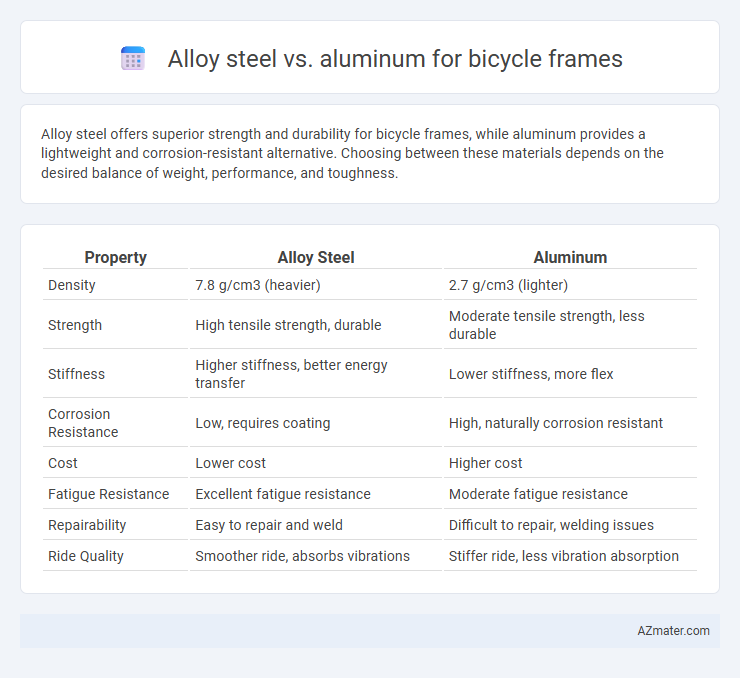Alloy steel offers superior strength and durability for bicycle frames, while aluminum provides a lightweight and corrosion-resistant alternative. Choosing between these materials depends on the desired balance of weight, performance, and toughness.
Table of Comparison
| Property | Alloy Steel | Aluminum |
|---|---|---|
| Density | 7.8 g/cm3 (heavier) | 2.7 g/cm3 (lighter) |
| Strength | High tensile strength, durable | Moderate tensile strength, less durable |
| Stiffness | Higher stiffness, better energy transfer | Lower stiffness, more flex |
| Corrosion Resistance | Low, requires coating | High, naturally corrosion resistant |
| Cost | Lower cost | Higher cost |
| Fatigue Resistance | Excellent fatigue resistance | Moderate fatigue resistance |
| Repairability | Easy to repair and weld | Difficult to repair, welding issues |
| Ride Quality | Smoother ride, absorbs vibrations | Stiffer ride, less vibration absorption |
Introduction: Alloy Steel vs Aluminum for Bicycle Frames
Alloy steel offers high tensile strength and durability, making it ideal for heavy-duty bicycle frames that require impact resistance and longevity. Aluminum frames are significantly lighter and provide excellent corrosion resistance, enhancing speed and ease of handling during rides. The choice between alloy steel and aluminum depends on the desired balance of weight, strength, and ride comfort for cycling performance.
Material Composition and Properties
Alloy steel bicycle frames typically consist of iron combined with elements like chromium, nickel, and molybdenum, providing exceptional tensile strength, durability, and fatigue resistance ideal for rugged riding conditions. Aluminum frames, made from lightweight alloys such as 6061 or 7005 series primarily composed of aluminum, magnesium, and sometimes silicon, offer superior corrosion resistance and a low weight-to-strength ratio, enhancing speed and agility. While alloy steel excels in impact absorption and longevity, aluminum provides a stiffer ride with less weight, making material composition critical in choosing the right frame for performance and terrain.
Strength and Durability Comparison
Alloy steel bicycle frames offer superior strength and exceptional durability due to their high tensile strength and resistance to fatigue, making them ideal for heavy-duty and long-term use. Aluminum frames provide a lightweight alternative with good corrosion resistance, but they typically have lower impact strength and a shorter fatigue life compared to alloy steel. For riders prioritizing frame longevity and toughness, alloy steel is generally the preferred choice despite the added weight.
Weight Differences and Riding Performance
Alloy steel bicycle frames typically weigh more than aluminum frames, often adding several hundred grams due to denser metal composition. This increased weight can contribute to better vibration dampening and durability, enhancing riding comfort on rough terrains. Aluminum frames, being lighter, improve acceleration and climbing efficiency, making them ideal for competitive cycling and speed-focused rides.
Fatigue Resistance and Flexibility
Alloy steel offers superior fatigue resistance compared to aluminum, making it ideal for bicycle frames subjected to repeated stress and long-term durability demands. Aluminum frames excel in flexibility and lightweight properties but tend to have lower fatigue resistance, which can lead to earlier material fatigue and potential failure under continuous load cycles. Choosing alloy steel enhances frame longevity and structural integrity, while aluminum prioritizes weight savings and shock absorption.
Corrosion Resistance and Maintenance
Aluminum bicycle frames offer superior corrosion resistance compared to alloy steel due to the natural oxide layer that protects aluminum from rusting, making them ideal for wet or humid environments. Alloy steel frames require protective coatings or regular maintenance such as painting or rust-proofing to prevent corrosion and ensure longevity. Maintenance on aluminum frames is generally lower, as they do not need frequent inspections for rust, unlike alloy steel which demands consistent care to maintain structural integrity.
Cost Considerations and Affordability
Alloy steel bicycle frames generally offer a more affordable option due to lower raw material costs and simpler manufacturing processes compared to aluminum frames. Aluminum frames, while lightweight and corrosion-resistant, typically involve higher production expenses resulting in increased retail prices. For budget-conscious cyclists, alloy steel provides durable performance at a more accessible price point without significant compromise on strength.
Ride Quality and Comfort
Alloy steel bicycle frames offer superior ride quality due to their excellent vibration damping and higher stiffness, which provides a smooth and controlled ride on uneven terrain. Aluminum frames tend to be lighter but transmit more road vibrations to the rider, resulting in a firmer feel that may compromise comfort during long rides. Riders prioritizing comfort and shock absorption often prefer alloy steel for its balanced combination of durability and ride smoothness.
Suitability for Different Cycling Styles
Alloy steel offers superior strength and durability, making it ideal for mountain biking and touring where impact resistance and load-bearing capacity are crucial. Aluminum frames excel in road cycling and racing due to their lightweight properties and stiffness, providing faster acceleration and efficiency on paved surfaces. Riders seeking versatility might prefer steel for comfort and reliability across varied terrains, while those prioritizing speed and agility often choose aluminum.
Environmental Impact and Sustainability
Alloy steel bicycle frames offer durability and recyclability, but their production involves higher carbon emissions due to energy-intensive mining and smelting processes. Aluminum frames provide a lighter option with lower weight per bike, contributing to fuel efficiency during transportation, and aluminum recycling uses less energy compared to primary production, reducing its environmental footprint. Selecting aluminum generally supports better sustainability through energy-efficient recycling, while steel's longer lifespan can offset initial higher environmental costs if maintained properly.

Infographic: Alloy steel vs Aluminum for Bicycle frame
 azmater.com
azmater.com